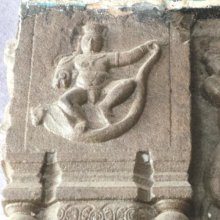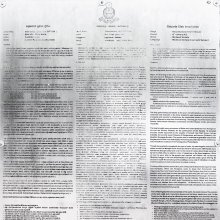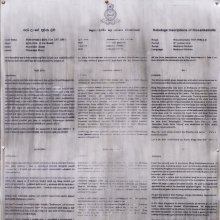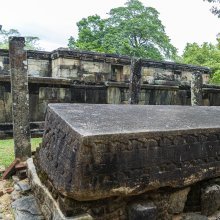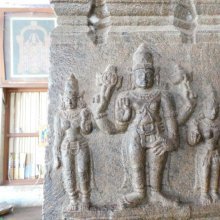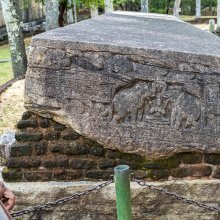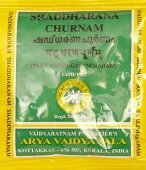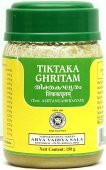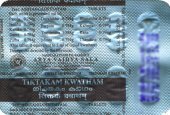Kalinga, Kāliṅga, Kaliṅga, Kalimga: 43 definitions
Introduction:
Kalinga means something in Buddhism, Pali, Hinduism, Sanskrit, Jainism, Prakrit, the history of ancient India, biology. If you want to know the exact meaning, history, etymology or English translation of this term then check out the descriptions on this page. Add your comment or reference to a book if you want to contribute to this summary article.
Images (photo gallery)
(+1 more images available)
In Hinduism
Ayurveda (science of life)
Cikitsa (natural therapy and treatment for medical conditions)
Source: Ancient Science of Life: Botanical identification of plants described in Mādhava CikitsāKaliṅga (कलिङ्ग) (or Kuṭaja, Indrayava, Vatsaka) refers to the medicinal plant Holarrhena antidysenterica (Roth) A. DC, and is used in the treatment of atisāra (diarrhoea), according to the 7th century Mādhavacikitsā chapter 2. Atisāra refers to a condition where there are three or more loose or liquid stools (bowel movements) per day or more stool than normal. The second chapter of the Mādhavacikitsā explains several preparations [including Kaliṅga] through 60 Sanskrit verses about treating this problem.
Veterinary Medicine (The study and treatment of Animals)
Source: Shodhganga: Portrayal of Animal Kingdom (Tiryaks) in Epics An Analytical studyKaliṅga (कलिङ्ग) refers to the Greater hoopoe lark (Alaemon alaudipes), according to scientific texts such as the Mṛgapakṣiśāstra (Mriga-pakshi-shastra) or “the ancient Indian science of animals and birds” by Hamsadeva, containing the varieties and descriptions of the animals and birds seen in the Sanskrit Epics such as the Ramayana and Mahabharata.
Unclassified Ayurveda definitions
Source: Wisdom Library: Āyurveda and botanyKaliṅga (कलिङ्ग):—A Sanskrit word referring to the “Kurchi” plant and is used throughout Ayurvedic literature such as the Caraka-saṃhitā. Its official botanical name is Holarrhena antidysenterica and is commonly referred to in English as the “coral swirl”, “tellincherry bark” or “white angel”

Āyurveda (आयुर्वेद, ayurveda) is a branch of Indian science dealing with medicine, herbalism, taxology, anatomy, surgery, alchemy and related topics. Traditional practice of Āyurveda in ancient India dates back to at least the first millenium BC. Literature is commonly written in Sanskrit using various poetic metres.
Purana and Itihasa (epic history)
Source: archive.org: Puranic Encyclopedia1) Kaliṅga (कलिङ्ग).—Ṛtāyu, King of Kaliṅga was present at the svayaṃvara of Draupadī. (Śloka 13, Chapter 185 Ādi Parva). Rukmī played a game of dice with Balabhadra with the help of Kaliṅga (for details see under Rukmī). The sage Dīrghatamas begot a son of the wife of the aged and senile Kaliṅga and the boy was named Kakṣīvān (Sūkta 125, Anuvāka 18, Maṇḍala 1, Ṛgveda). (See full article at Story of Kaliṅga from the Puranic encyclopaedia by Vettam Mani)
2) Kaliṅga (कलिङ्ग).—A warrior of the god Skandha. (Mahābhārata Śalya Parva, Chapter 45, Verse 64).
3) Kaliṅga (कलिङ्ग).—A Daitya who lived in Kṛtayuga. In Skanda Purāṇa there is a story that he conquered heaven, drove away the Dikpālakas, posted his own forces in their place and was finally killed by Devī.
4) Kāliṅga (कालिङ्ग).—Śrutāyus, King of Kaliṅga, and a member of Yudhiṣṭhira’s assembly. (Sabhā Parva, Chapter 4).
5) Kaliṅga (कलिङ्ग).—(M) (kāliṅga) An ancient place in the south of Bhārata. Other details.
Arjuna visited this place while he was on a pilgrimage. (Śloka 9, Chapter 214, Ādi Parva).
Kaliṅga was also included in the countries conquered by Sahadeva while he was on his victory march. (Chapter 31, Sabhā Parva).
People from Kaliṅga presented Yudhiṣṭhira with gifts for the Rājasūya. (Śloka 18, Chapter 52. Sabhā Parva).
Yudhiṣṭhira visited Kaliṅga while he was on a pilgrimage. (Śloka 4, Chapter 114, Vana Parva).
Karṇa conquered Kaliṅga while he was on a victory march. (Śloka 8, Chapter 254, Vana Parva).
Sahadeva defeated the King of Kaliṅga. (Śloka 24, Chapter 23, Udyoga Parva).
Śrī Kṛṣṇa slaughtered the people of Kaliṅga. (Śloka 76, Chapter 48, Udyoga Parva).
The people of Kaliṅga took part in the war between the Pāṇḍavas and Kauravas. (Śloka 6, Chapter 20, Droṇa Parva).
Paraśurāma conquered this place. (Śloka 12, Chapter 70, Dṛoṇa Parva).
Source: Cologne Digital Sanskrit Dictionaries: The Purana Index1a) Kaliṅga (कलिङ्ग).—A Kṣetraja son of Bali; after him came Kaliṅgas (s.v.);1 a Rākṣasa in the Atalam. (Tatvalam, Brahmāṇḍa-purāṇa.).2
- 1) Brahmāṇḍa-purāṇa III. 74. 28 & 87; Matsya-purāṇa 48. 25; Vāyu-purāṇa 99. 28; Viṣṇu-purāṇa IV. 18. 13-14.
- 2) Vāyu-purāṇa 50. 17; Brahmāṇḍa-purāṇa II. 19. 18.
1b) (Mt.) a hill on the south of the Mānasa.*
- * Vāyu-purāṇa 36. 22; 42. 28.
1c) A southern kingdom of madhyadeśa unfit for śrāddha; a Janapada of the Dakṣiṇāpatha. Its king was stationed by Jarāsandha on the east gate of Mathurā, and on the same direction during the siege of Gomanta;1 present at Pradyumna's marriage. Advised Rukmin to vanquish Balarāma in dice, and laughed at the latter when he was defeated. His teeth were broken by Rāma.2 Its 32 kings.3 On its south flows the Narmadā where the hill Amarakaṇṭaka is.4 In the kṛtayuga, the first man appeared in this country5 under Guhas.6
- 1) Brahmāṇḍa-purāṇa II. 16. 42 & 57; III. 13. 13; 14. 33 & 80; 74. 198 & 213; Matsya-purāṇa 163. 72; Vāyu-purāṇa 77. 13; 78. 23; 99. 324, 386, 402.
- 2) Bhāgavata-purāṇa X. 50. 11[2]; 52. 11[5]; 61. 27-29; 32[1] & 37; IV. 5. 21; Viṣṇu-purāṇa V. 28. 10, 15, 24.
- 3) Matsya-purāṇa 272. 16.
- 4) Matsya-purāṇa 186. 12.
- 5) Vāyu-purāṇa 58. 110.
- 6) Viṣṇu-purāṇa III. 7. 36.
1d) A tribe born of Dīrghatamas and Bali's wife; enlisted by Jarāsandha against the Yadus;1 people of the Dakṣiṇāpatha.2
- 1) Bhāgavata-purāṇa IX. 23. 5; X. [50 (V) 3]; Matsya-purāṇa 114. 36 and 47; Vāyu-purāṇa 45. 125.
- 2) Vāyu-purāṇa 45. 125; Viṣṇu-purāṇa II. 3. 16.
2) Kāliṅga (कालिङ्ग).—The king of, present at the marriage of Anīruddha and advised Rukmin to invite Rāma for dice. Laughed aloud when Rāma failed, and supported Rukmin playing falsely. His teeth pulled out by Rāma.*
- * Bhāgavata-purāṇa X. 61. 27-37.
Kaliṅga (कलिङ्ग) is a name mentioned in the Mahābhārata (cf. I.61.60) and represents one of the many proper names used for people and places. Note: The Mahābhārata (mentioning Kaliṅga) is a Sanskrit epic poem consisting of 100,000 ślokas (metrical verses) and is over 2000 years old.
Source: Shodhganga: The saurapurana - a critical studyKaliṅga (कलिङ्ग) refers to an ancient country which should be shunned, according to the 10th century Saurapurāṇa: one of the various Upapurāṇas depicting Śaivism.—It looks upon Kurukṣetra, Matsya, Pāñcāla and Surasena as holy countries where Dharma is practiced. It advises people to shun Aṅga, Vaṅga, Kaliṅga, Surāṣṭra, Gurjara, Ābhira, Kauṅkaṇa, Draviḍa, Dakṣiṇāpatha, Āndhra and Magadha.—(cf. verses 17.54-59) Thus it appears that this Purāṇa was written somewhere about the north-western part of northern India.

The Purana (पुराण, purāṇas) refers to Sanskrit literature preserving ancient India’s vast cultural history, including historical legends, religious ceremonies, various arts and sciences. The eighteen mahapuranas total over 400,000 shlokas (metrical couplets) and date to at least several centuries BCE.
Vastushastra (architecture)
Source: Wisdom Library: Vāstu-śāstraKaliṅga (कलिङ्ग) refers to a variety of prāsāda (upper storey of any building), according to the Śilparatna (32.6), the Mayamata (18.10), the Kamikāgama (57.8) and the Īśānaśiva (32-70).

Vastushastra (वास्तुशास्त्र, vāstuśāstra) refers to the ancient Indian science (shastra) of architecture (vastu), dealing with topics such architecture, sculpture, town-building, fort building and various other constructions. Vastu also deals with the philosophy of the architectural relation with the cosmic universe.
Natyashastra (theatrics and dramaturgy)
Source: Wisdom Library: Nāṭya-śāstraKaliṅga (कलिङ्ग) is the name of a country situated within the Dākṣiṇāpatha (Deccan) region. Countries within this region pertain to the Dākṣinātyā local usage (pravṛtti) according to the Nāṭyaśāstra chapter 14. These pravṛttis provide information regarding costumes, languages, and manners in different countries of the world. It is mentioned this region lies between the Southern Ocean and the Vindhya mountains.
The Kaliṅgas are usually to be represented by a dark or deep blue (śyāma) color when painting the limbs (aṅgaracanā), according to Nāṭyaśāstra chapter 23. The painting is a component of nepathya (costumes and make-up) and is to be done in accordance with the science of āhāryābhinaya (extraneous representation).

Natyashastra (नाट्यशास्त्र, nāṭyaśāstra) refers to both the ancient Indian tradition (shastra) of performing arts, (natya—theatrics, drama, dance, music), as well as the name of a Sanskrit work dealing with these subjects. It also teaches the rules for composing Dramatic plays (nataka), construction and performance of Theater, and Poetic works (kavya).
Kavya (poetry)
Source: Wisdom Library: KathāsaritsāgaraKaliṅga (कलिङ्ग) is the name of a kingdom that was conquered by Udayana (king of Vatsa) during his campaign to obtain sovereignty over the whole earth, according to the Kathāsaritsāgara, chapter 19. Accordingly, “Then the people of Kaliṅga submitted and paid tribute, and acted as the king’s guides, so that the renown of that renowned one ascended the mountain of Mahendra”.
The Kathāsaritsāgara (‘ocean of streams of story’), mentioning Kaliṅga, is a famous Sanskrit epic story revolving around prince Naravāhanadatta and his quest to become the emperor of the vidyādharas (celestial beings). The work is said to have been an adaptation of Guṇāḍhya’s Bṛhatkathā consisting of 100,000 verses, which in turn is part of a larger work containing 700,000 verses.
Source: archive.org: The ocean of story, vol. 1Kaliṅga (कलिङ्ग) is usually described as extending from Orissa to Drāviḍa or below Madras, the coast of the Northern Circars. It appears, however, to be sometimes the Delta of the Ganges. It was known to the ancients as Regio Caliṅgarum, and is familiar to the natives of the Eastern Archipelago by the name of Kling (Wilson).
Source: archive.org: Aspects of Bengal society: Ship-building and commerceKalinga is the name of an ancient city mentioned by the author of the Kavikankan’s Chandikāvya pp. 195-202.—Accordingly, after the performance of the usual ceremonies before sailing, the merchant Dhanapati passed the following places: [...]—all by the side of the Ganges. Then he reached the very celebrated inland port of Bengal known as Saptagram near the Tribeni. The poet here incidentally praised this port and gave it a superiour place among the following ports and places: [e.g., Kalinga, etc...]. According to the poet the merchants of the above places visit Saptagram but the merchants of Saptagram do never visit those ports and places.
Source: Shodhganga: The Kavyamimamsa of RajasekharaKaliṅga (कलिङ्ग) is the name a locality mentioned in Rājaśekhara’s 10th-century Kāvyamīmāṃsā.—The northern Circārs, a place lying between Orissa in the north and Andhra in the south on bordering on the sea. In the Kāvyamīmāṃsā described this place amongst the countries situated in the southern and the eastern India.

Kavya (काव्य, kavya) refers to Sanskrit poetry, a popular ancient Indian tradition of literature. There have been many Sanskrit poets over the ages, hailing from ancient India and beyond. This topic includes mahakavya, or ‘epic poetry’ and natya, or ‘dramatic poetry’.
Shaktism (Shakta philosophy)
Source: Wisdom Library: ŚāktismKaliṅga (कलिङ्ग) is the name of a Śāktapīṭha mentioned in the Kulārṇavatantra. The Kulārṇava-tantra is an important 11th century work for the Kaula school of Śāktism. It refers to eighteen such Śākta-pīṭhas (e.g. Kaliṅga) which is defined as a sacred sanctuary of Devī located here on earth. According to legend, there are in total fifty-one such sanctuaries (pīṭha) on earth, created from the corresponding parts of Devī’s body,

Shakta (शाक्त, śākta) or Shaktism (śāktism) represents a tradition of Hinduism where the Goddess (Devi) is revered and worshipped. Shakta literature includes a range of scriptures, including various Agamas and Tantras, although its roots may be traced back to the Vedas.
Pancaratra (worship of Nārāyaṇa)
Source: eScholarship: Chapters 1-14 of the Hayasirsa PancaratraKaliṅga (कलिङ्ग) is the name of an ancient region, being born from there represents an undesirable characteristic of an Ācārya, according to the 9th-century Hayaśīrṣa-pañcarātra Ādikāṇḍa chapter 3.—The Lord said:—“I will tell you about the Sthāpakas endowed with perverse qualities. He should not construct a temple with those who are avoided in this Tantra. [...] Nor originating in Kāmarūpa or Kaliṅga, or Kāñcī, Kāśmīra or Kośala, nor one having bad behavior, bad company or come from Mahārāṣṭra. [...] A god enshrined by any of these named above (viz., kaliṅga), is in no manner a giver of fruit. If a building for Viṣṇu is made anywhere by these excluded types (viz., kaliṅga) then that temple will not give rise to enjoyment and liberation and will yield no reward, of this there is no doubt”.

Pancaratra (पाञ्चरात्र, pāñcarātra) represents a tradition of Hinduism where Narayana is revered and worshipped. Closeley related to Vaishnavism, the Pancaratra literature includes various Agamas and tantras incorporating many Vaishnava philosophies.
Jyotisha (astronomy and astrology)
Source: Wisdom Library: Brihat Samhita by VarahamihiraKaliṅga (कलिङ्ग) refers to a country [identified with a district on the Coromandal coast (extending from below Cuttack to the vicinity of Madras)], belonging to “Āgneyī (south-eastern division)” classified under the constellations of Āśleṣā, Maghā and Pūrvaphālguni, according to the system of Kūrmavibhāga, according to the Bṛhatsaṃhitā (chapter 14), an encyclopedic Sanskrit work written by Varāhamihira mainly focusing on the science of ancient Indian astronomy astronomy (Jyotiṣa).—Accordingly, “The countries of the Earth beginning from the centre of Bhāratavarṣa and going round the east, south-east, south, etc., are divided into 9 divisions corresponding to the 27 lunar asterisms at the rate of 3 for each division and beginning from Kṛttikā. The constellations of Āśleṣā, Maghā and Pūrvaphālguni represent the south-eastern division consisting of [i.e., Kaliṅga] [...]”.

Jyotisha (ज्योतिष, jyotiṣa or jyotish) refers to ‘astronomy’ or “Vedic astrology” and represents the fifth of the six Vedangas (additional sciences to be studied along with the Vedas). Jyotisha concerns itself with the study and prediction of the movements of celestial bodies, in order to calculate the auspicious time for rituals and ceremonies.
General definition (in Hinduism)
Source: archive.org: Indian Historical Quarterly Vol. 7Kaliṅga (कलिङ्ग) is the name of a country classified as both Hādi and Kādi (two types of Tantrik division), according to the 13th century Sammoha-tantra (fol. 7).—There are ample evidences to prove that the zone of heterodox Tantras went far beyond the natural limits of India. [...] The zones in the Sammoha-tantra [viz., Kaliṅga] are here fixed according to two different Tantrik modes, known as Kādi and Hādi.
In Buddhism
Theravada (major branch of Buddhism)
Source: Pali Kanon: Pali Proper Names1. Kalinga, Kalinga - An inhabitant of Natika. While staying in Natika, at the Ginjakavasatha, the Buddha tells Ananda that Kalinga was reborn after death in the Suddhavasa, and that there he would attain to nibbana. D.ii.92; S.v.358f
2. Kalinga - A country: the Kalingarattha. It is one of the seven political divisions mentioned in the time of the mythical king Renu and is given first in the list, its capital being Dantapura and its king Sattabhu. (D.ii.235f; see also Mtu.iii.208; the Mtu. also mentions a king Uggata of Dantapura, iii.364f).
It is not, however, included in the list of sixteen Janapadas appearing in the Anguttara Nikaya (A.i.213, etc.), but is found in the extended list of the Niddesa (CNid.ii.37). A later tradition (Bu.xviii.6) states that after the Buddhas death, a Tooth was taken from among his relics and placed at Kalinga, where it was worshipped. From Kalinga the Tooth was brought to Ceylon, in the time of King Sirimeghavanna, by Hemamala, daughter of Guhasiva, king of Kalinga, and her husband Dantakumara, a prince of the Ujjeni royal family. In Ceylon the Tooth became the Palladium of the Sinhalese kings. (Cv.xxxvii.92; see also Cv.Trs.i.7, n.4; the Dathadhatuvamsa gives details, J.P.T.S.1884, pp.108ff).
The Jatakas contain various references to Kalinga. There was once a great drought in Dantapura, and the king, acting on the advice of his ministers, sent brahmins to the king of Kuru to beg the loan of his state elephant, Anjanavasabha, credited with the power of producing rain. On this occasion, however, the elephant failed and the Kalinga king, hearing of the virtues practised by the king and people of Dantapura, offered them himself, upon which rain fell. See the Kurudhamma Jataka, J.ii.367ff, also DhA.iv.88f. A similar story is related in the Vessantara Jataka, vi.487, where the Kalinga brahmins ask for and obtain Vessantaras white elephant that he may stay the drought in Kalinga.
Another king of Kalinga was a contemporary of Aruna, the Assaka king of Potali. The Kalinga king, in his eagerness for a fight, picked a quarrel with Aruna, but was worsted in battle, and had to surrender his four daughters with their dowries to Aruna (J.iii.3f).
The Kalingabodhi Jataka relates the story of another ruler of Kalinga while, according to the Sarabhanga Jataka, a certain king of Kalinga (J.v.135f) went with two other kings, Atthaka and Bhimaratta, to ask Sarabhanga questions referring to the fate of Dandaki. There they heard the sage preach, and all three kings became ascetics. Another king of Kalinga was Nalikira, who, having ill treated a holy man, was swallowed up in the Sunakha niraya, while his country was laid waste by the gods and turned into a wilderness (Kalingaranna). The Kalinga aranna is referred to in the Upali Sutta (M.i.378);
Theravāda is a major branch of Buddhism having the the Pali canon (tipitaka) as their canonical literature, which includes the vinaya-pitaka (monastic rules), the sutta-pitaka (Buddhist sermons) and the abhidhamma-pitaka (philosophy and psychology).
Tibetan Buddhism (Vajrayana or tantric Buddhism)
Source: Wisdomlib Libary: VajrayoginiKaliṅga (कलिङ्ग) is the name of a sacred site (pīṭha) presided over by Śyāmā (or Śyāmādevī), according to the vārāhyabhyudaya-maṇḍala. Śyāmādevī is a deity situated in one of the six petals of the western lotus, of which the presiding deity is kuleśvarī (presiding lady) named Tārā. The central deity of the vārāhyabhyudaya-maṇḍala is the twelve-armed Vajravarāhī.
Kaliṅga is one of the twenty-four pīṭhas, or ‘sacred-site’ (six lotuses each having six petals), each corresponding with a part of the human body. Kaliṅga is to be contemplated as situated in the mouth. Besides being associated with a bodily spot, each pīṭha represents an actual place of ancient India frequented particularly by advanced tantric practitioners
Source: academia.edu: A Critical Study of the Vajraḍākamahātantrarāja (II)Kaliṅga (कलिङ्ग) is one of the two Chandoha (‘sacred spot’) present within the Vākcakra (‘circle of word’) which is associated with the Ḍākinī named Bhūcarī (‘a woman going on the ground’), according to the 9th-centruy Vajraḍākatantra. Vākcakra is one of three Cakras within the Tricakra system which embodies twenty-four sacred spots or districts (viz., Kaliṅga) resided over by twenty-four ‘sacred girls’ (ḍākinīs) whose husbands abide in one’s body in the form of twenty-four ingredients (dhātu) of one’s body.
Kaliṅga has the presiding Ḍākinī named Śyāmādevī whose husband, or hero (vīra) is named Subhadra. The associated internal location is the ‘mouth’ and the bodily ingredients (dhātu) are the ‘ribs’. According to the Vajraḍākavivṛti, the districts Kaliṅga, Kosala, Suvarṇadvīpa and Oḍyāyana are associated with the family deity of Caṇḍikā; while in the Abhidhānottarottaratantra there is the Ḍāka deity named Padmaḍāka standing in the center of the districts named Kaliṅga, Kāñcī, Lampāka and Himālaya (Himagiri).
Source: OSU Press: Cakrasamvara SamadhiKaliṅga (कलिङ्ग) is the pīṭha associated with Śyāmādevī and Subhadra, according to the Cakrasaṃvara-maṇḍala or Saṃvaramaṇḍala of Abhayākaragupta’s Niṣpannayogāvalī, p. 45 and n. 145; (Cf. Cakrasaṃvaratantra, Gray, David B., 2007).—The Cakrasaṃvara mandala has a total of sixty-two deities. [...] Three concentric circles going outward, the body, speech and mind wheels (kāya-vāka-citta), in the order: mind (blue), speech (red), and body (white), with eight Ḍākinīs each in non-dual union with their Ḍākas, "male consorts".
Associated elements of Śyāmādevī and Subhadra:
Circle: vākacakra [=vākcakra?] (speech-wheel) (red);
Ḍākinī (female consort): Śyāmādevī;
Ḍāka (male consort): Subhadra;
Bīja: kaṃ;
Body-part: mouth;
Pīṭha: Kaliṅga;
Bodily constituent: guṇavarti (small intestine);
Bodhipakṣa (wings of enlightenment): samādhibala (power of concentration).
Kaliṅga (कलिङ्ग) is the name of Upakṣetra (category of holy sites), according to the 10th-century Ḍākārṇava-tantra: one of the last Tibetan Tantric scriptures belonging to the Buddhist Saṃvara tradition consisting of 51 chapters.—Accordingly: “Now, [the Blessed One] has taught [holy sites] such as the kṣetra and upakṣetra in sequence. [...] (3) Kāmarūpa, Oḍra, Triśakuna (for Triśakuni), and Kauśala are the kṣetra [sites]. (4) The upakṣetra [sites] are Kaliṅga, Lampāka, Kāñcī, and Himālaya. [...] Girls who are in these places are of [the nature of] the innate, born in their own birthplaces. [...]”.

Tibetan Buddhism includes schools such as Nyingma, Kadampa, Kagyu and Gelug. Their primary canon of literature is divided in two broad categories: The Kangyur, which consists of Buddha’s words, and the Tengyur, which includes commentaries from various sources. Esotericism and tantra techniques (vajrayāna) are collected indepently.
In Jainism
General definition (in Jainism)
Source: archive.org: TrisastisalakapurusacaritraKaliṅga (कलिङ्ग) (distinguished by the city Kāñcanapurī) refers to one of the 25½ countries of the Kṣetrāryas, situated in the “middle world” (madhyaloka), according to chapter 2.3 [ajitanātha-caritra] of Hemacandra’s 11th century Triṣaṣṭiśalākāpuruṣacaritra (“lives of the 63 illustrious persons”): a Sanskrit epic poem narrating the history and legends of sixty-three important persons in Jainism.
Accordingly:—“In these 35 zones on this side of Mānuṣottara and in the Antaradvīpas, men arise by birth; [...]. From the division into Āryas and Mlecchas they are two-fold. The Āryas have sub-divisions [e.g., kṣetra (country)]. [...] The kṣetrāryas are born in the 15 Karmabhumis. Here in Bharata they have 25½ places of origin (e.g., Kaliṅga), distinguishable by cities (e.g., Kāñcanapurī) in which the birth of Tīrthakṛts, Cakrabhṛts, Kṛṣṇas, and Balas takes place”.

Jainism is an Indian religion of Dharma whose doctrine revolves around harmlessness (ahimsa) towards every living being. The two major branches (Digambara and Svetambara) of Jainism stimulate self-control (or, shramana, ‘self-reliance’) and spiritual development through a path of peace for the soul to progess to the ultimate goal.
India history and geography
Source: archive.org: Shiva Purana (history)Kaliṅga (कलिङ्ग) or Kaliṅgadeśa occupied the narrower eastern coastal plain form the delta of the Godāvarī to that of the Mahānadī river. It was probably one of the best-known regions of the south known to ancient Indian literature.
Source: academia.edu: The Date of Kharavela, a Great King of KalingaKalinga was an ancient kingdom of Eastern India. Duryodhana eloped with the daughter of Kalinga king Chitrangada of Rajapura and married her. Kalinga King Shrutāyudha or Shrutāyush (probably, from the city of Dantapura) participated in the Mahabharata war in support of Kauravas but got killed by Bhima. Kalinga was only a Janapada during Mahabharata period, probably, part of Ashmaka Mahajanapada. It appears that Kalinga became Mahajanapada around 2000 BCE because early Buddhist texts mention Kalinga as Mahajanapada.
Source: Ancient Buddhist Texts: Geography of Early BuddhismKaliṅga (कलिङ्ग) or Kaliṅgaraṭṭha is the name of a locality situated in Dakkhiṇāpatha (Deccan) or “southern district” of ancient India, as recorded in the Pāli Buddhist texts (detailing the geography of ancient India as it was known in to Early Buddhism).—The inscriptions of Asoka tell us that Asoka in the 13th year of his reign conquered the kindom of Kaliṅga and incorporated in into his own empire. From the Kaliṅga Edict I, it appears that a Kumāra was in charge of Kaliṅga with his headquarters at Tosali (Tosala) or Samāpa. According to the Mahābhārata the ancient Kaliṅga country seems to have comprised modern Orissa to the south of the Vaitaraṇī and the sea coast southward as far as Vizagapatam and its capital was Rājapura (Śāntiparva, IV).
The Hāthigumphā inscription clearly shows that the capital of Kaliṅga during the reign of Khāravela was Kaliṅganagara which has been satisfactorily identified with Mukhalingaṃ on the Vaṃśadharā and the adjacent ruins in Ganjam district, Madras Presidency. According to the Mahāvastu Dantapura which is mentioned by Yuan Chwang as a city of the Kaliṅga country was a capital city. Evidently it was the capital of the Kaliṅga kingdom (according to Mahāvastu), and existed ages before the Buddha.
Source: Orissa Reference Annual: Maritime Traditions of OrissaKalinga refers to a group of people originating from Orissa (Odisha).—The people of Orissa had great expertise in sea voyage in ancient and medieval times. From the folklores, folksongs, traditions, customs and literature, it is found that the Oriyas had commercial as well as cultural relationship across the seas. It is said that the people of Kalinga were the pioneers in colonising the far-off lands of Sumatra, Java, Indonesia, Burma, Siam and other countries. They had also social relationship with the people of Srilanka. They had acquired wealth and power through this maritime trade and colonial expansion. So in the history of India, the people of Orissa had also contributed considerably. [...] It is a fact that during ancient and early medieval time, entire Southern India was busy with overseas trade. But the Kalingans were predominant among them. It is well-known that the people of Kalinga were great fighters, empire builders and patron of art and culture in the annals of world history.

The history of India traces the identification of countries, villages, towns and other regions of India, as well as mythology, zoology, royal dynasties, rulers, tribes, local festivities and traditions and regional languages. Ancient India enjoyed religious freedom and encourages the path of Dharma, a concept common to Buddhism, Hinduism, and Jainism.
Biology (plants and animals)
Source: Wisdom Library: Local Names of Plants and DrugsKalinga [कलिंग] in the Hindi language is the name of a plant identified with Caesalpinia bonduc (L.)Roxb. from the Caesalpiniaceae (Gulmohar) family having the following synonyms: Caesalpinia crista, Caesalpinia bonducella, Guilandina bonduc. For the possible medicinal usage of kalinga, you can check this page for potential sources and references, although be aware that any some or none of the side-effects may not be mentioned here, wether they be harmful or beneficial to health.
Kalinga [କଳିଙ୍ଗ] in the Odia language, ibid. previous identification.
Kalinga [कलिङ्ग] in the Sanskrit language, ibid. previous identification.
Kalinga [کلنگ] in the Urdu language, ibid. previous identification.
Kalinga [कलिंग] in the Hindi language is the name of a plant identified with Pongamia pinnata (L.) Pierre from the Fabaceae (pea) family having the following synonyms: Millettia pinnata, Pongamia glabra, Derris indica, Cytisus pinnatus.
Source: Google Books: CRC World Dictionary (Regional names)1) Kalinga in India is the name of a plant defined with Albizia lebbeck in various botanical sources. This page contains potential references in Ayurveda, modern medicine, and other folk traditions or local practices It has the synonym Mimosa lebbek Forssk. (among others).
2) Kalinga is also identified with Citrullus lanatus It has the synonym Cucumis vulgaris E.H.L. Krause (etc.).
3) Kalinga is also identified with Dillenia indica It has the synonym Dillenia speciosa Thunberg (etc.).
4) Kalinga is also identified with Holarrhena pubescens It has the synonym Physetobasis macrocarpa Hassk. (etc.).
Example references for further research on medicinal uses or toxicity (see latin names for full list):
· Not. Pl. Asiat. (1854)
· Species Plantarum (1753)
· Annales des Sciences Naturelles; Botanique (1844)
· Memoirs of the Wernerian Natural History Society (1810)
· FBI (1872)
· Catalogus Seminum et Sporarum in Horto Botanico Universitatis Imperialis Tokyoensis (1915)
If you are looking for specific details regarding Kalinga, for example chemical composition, health benefits, extract dosage, side effects, pregnancy safety, diet and recipes, have a look at these references.

This sections includes definitions from the five kingdoms of living things: Animals, Plants, Fungi, Protists and Monera. It will include both the official binomial nomenclature (scientific names usually in Latin) as well as regional spellings and variants.
Languages of India and abroad
Pali-English dictionary
Source: BuddhaSasana: Concise Pali-English Dictionarykāliṅga : (m.) name of a country in East India.

Pali is the language of the Tipiṭaka, which is the sacred canon of Theravāda Buddhism and contains much of the Buddha’s speech. Closeley related to Sanskrit, both languages are used interchangeably between religions.
Sanskrit dictionary
Source: DDSA: The practical Sanskrit-English dictionaryKaliṅga (कलिङ्ग).—a.
1) Clever.
2) Cunning.
-gāḥ (pl.) Name of a country and its inhabitants; (a district on the Coromandel coast); नो खण्डिकाञ्जगाम नो कलिङ्गाञ्जगाम (no khaṇḍikāñjagāma no kaliṅgāñjagāma) Mahābhārata on P.III.2.115. उत्कलादर्शितपथः कलिङ्गाभिमुखो ययौ (utkalādarśitapathaḥ kaliṅgābhimukho yayau) R.4. 38; (its position is thus described in Tantras :-- jagannāthātsamārabhya kṛṣṇātīrāntagaḥ priye | kaliṅgadeśaḥ saṃprokto vāma- mārgaparāyaṇaḥ ||).
-ṅgaḥ 1 The fork-tailed shrike.
2) Name of several plants; (as śirīṣa, plakṣa &c.)
-ṅgā A beautiful woman.
-ṅgam Indra grain (indrayava).
--- OR ---
Kāliṅga (कालिङ्ग).—a. (-ṅgī f.) [कलिङ्ग-अण् (kaliṅga-aṇ)] Produced in, or belonging to, the Kaliṅga country.
-ṅgaḥ 1 A king of that country; प्रतिजग्राह कालिङ्गस्तमस्त्रैर्गजसाधनः (pratijagrāha kāliṅgastamastrairgajasādhanaḥ) R.4.4.
2) A snake of that country.
3) An elephant.
4) A species of cucumber.
5) A poisonous plant.
6) A sort of iron.
-ṅgāḥ (pl.) Name of a country; see कलिङ्ग (kaliṅga).
-ṅgam A water-melon.
Source: Cologne Digital Sanskrit Dictionaries: Shabda-Sagara Sanskrit-English DictionaryKaliṅga (कलिङ्ग).—m.
(-ṅgaḥ) 1. The febrifuge nut-plant, (Cæsalpinia bunduccella.) 2. The fork-tailed shrike, (Lanius forficatus, Lath.) 3. The name of a country; the name of Kalinga is applied in the Puranas to several places, but it especially signifies a district on the Coromandel coast, extending from below cuttack to the vicinity of Madras, (in this sense, like some other names of countries, it is usually confined to the plural number
(-ṅgāḥ) confounding the place with the people inhabiting it. nf.
(-ṅgaṃ-ṅgā) A medicinal seed, that of Echites antidysenterica. f.
(-ṅgā) 1. A woman of a good shape. 2. A plant, commonly Teori, (Convolvulus turpethum:) see trivṛt. E. kali strife, &c. ga from gam to go, khac aff.
--- OR ---
Kāliṅga (कालिङ्ग).—mfn.
(-ṅgaḥ-ṅgī-ṅgaḥ) Produced in or belonging to the Kalinga country. m.
(-ṅgaḥ) 1. An elephant. 2. A snake. 3. A species of cucumber, (Cucumis utilatissimus.) 4. A sort of iron. f. (-ṅgī) A gourd or cucumber. n.
(-ṅgaṃ) The water melon. E. kaliṅga a country, and aṇ aff.
Source: Cologne Digital Sanskrit Dictionaries: Benfey Sanskrit-English DictionaryKaliṅga (कलिङ्ग).—m. pl. The name of a people and their country, [Rāmāyaṇa] 2, 71, 16.
--- OR ---
Kāliṅga (कालिङ्ग).—i. e. kaliṅga + a, I. m. 1. A prince of the Kaliṅgas, [Raghuvaṃśa, (ed. Stenzler.)] 4, 40. 2. pl. = Kaliṅga, a people, Mahābhārata 8, 2066. Ii. f. gī, A princess of the Kaliṅgas, Mahābhārata 1, 3775.
Source: Cologne Digital Sanskrit Dictionaries: Cappeller Sanskrit-English DictionaryKaliṅga (कलिङ्ग).—[masculine] [Name] of a king, [plural] of a people.
--- OR ---
Kāliṅga (कालिङ्ग).—[adjective] coming from the country of the Kaliṅgas; [masculine] an inhabitant or king of it; [feminine] ngī princess of the Kaliṅgas.
Source: Cologne Digital Sanskrit Dictionaries: Aufrecht Catalogus Catalogorum1) Kaliṅga (कलिङ्ग) as mentioned in Aufrecht’s Catalogus Catalogorum:—poet. Mentioned in Bhojaprabandha Oxf. 150^b.
2) Kaliṅga (कलिङ्ग):—a commentator on the Amarakośa. Quoted by Ujjvaladatta and Rāyamukuṭa.
Source: Cologne Digital Sanskrit Dictionaries: Monier-Williams Sanskrit-English Dictionary1) Kaliṅga (कलिङ्ग):—m. [plural] Name of a people and their country (the Name is applied in the Purāṇas to several places, but especially signifies a district on the Coromandel coast, extending from below Cuttack [Kaṭaka] to the vicinity of Madras), [Mahābhārata; Harivaṃśa; Viṣṇu-purāṇa] etc.
2) m. an inhabitant of Kaliṅga, [Sāhitya-darpaṇa]
3) Name of a king of Kaliṅga (from whom the Kaliṅga people are said to have originated; he is sometimes mentioned as a son of Dīrghatamas and Sudeṣṇā, sometimes identified with Bali), [Mahābhārata; Harivaṃśa] etc.
4) Name of a being attending on Skanda, [Mahābhārata] ([edition] [Bombay edition]) ix, 45, 64 ([varia lectio] kalinda [edition] Calc.)
5) Name of several authors
6) the fork-tailed shrike, [cf. Lexicographers, esp. such as amarasiṃha, halāyudha, hemacandra, etc.]
7) Caesalpina Bonducella, [cf. Lexicographers, esp. such as amarasiṃha, halāyudha, hemacandra, etc.]
8) Wrightia antidysenteria, [cf. Lexicographers, esp. such as amarasiṃha, halāyudha, hemacandra, etc.]
9) Acacia Sirissa, [cf. Lexicographers, esp. such as amarasiṃha, halāyudha, hemacandra, etc.]
10) Ficus infectoria, [cf. Lexicographers, esp. such as amarasiṃha, halāyudha, hemacandra, etc.]
11) Kaliṅgā (कलिङ्गा):—[from kaliṅga] f. a beautiful woman, [cf. Lexicographers, esp. such as amarasiṃha, halāyudha, hemacandra, etc.]
12) [v.s. ...] Opomea Turpethum
13) Kaliṅga (कलिङ्ग):—n. the seed of Wrightia antidysenteria, [Suśruta]
14) mfn. clever, cunning, [cf. Lexicographers, esp. such as amarasiṃha, halāyudha, hemacandra, etc.]
15) Kāliṅga (कालिङ्ग):—m. ‘produced in or belonging to the Kaliṅga country’, a Kaliṅga man, [Viṣṇu-purāṇa]
16) ([Pāṇini 4-1, 170]) a prince of the Kaliṅgas, [Harivaṃśa; Raghuvaṃśa iv, 40 etc.]
17) ([plural]) the Kaliṅgas, [Mahābhārata; Viṣṇu-purāṇa]
18) an elephant, [cf. Lexicographers, esp. such as amarasiṃha, halāyudha, hemacandra, etc.]
19) a snake, [cf. Lexicographers, esp. such as amarasiṃha, halāyudha, hemacandra, etc.]
20) a species of cucumber (Cucumis usitatissimus), [cf. Lexicographers, esp. such as amarasiṃha, halāyudha, hemacandra, etc.]
21) Beninkasa cerifera
22) a poisonous plant, [cf. Lexicographers, esp. such as amarasiṃha, halāyudha, hemacandra, etc.]
23) a sort of iron
24) mn. the plant Wrightia antidysenterica, [Bhāvaprakāśa]
25) n. the water-melon.
Source: Cologne Digital Sanskrit Dictionaries: Yates Sanskrit-English Dictionary1) Kaliṅga (कलिङ्ग):—(ṅgaḥ) 1. m. The febrifuge nut plant; a forked tailed shrike; name of a country. f. (ṅgā) A medicinal plant; a fine woman.
2) Kāliṅga (कालिङ्ग):—[(gaḥ-gī-gaṃ)] 1. m. An elephant; a snake. 3. f. A cucumber. 1. n. Watermelon. a. Of Kalinga.
Source: DDSA: Paia-sadda-mahannavo; a comprehensive Prakrit Hindi dictionary (S)Kaliṅga (कलिङ्ग) in the Sanskrit language is related to the Prakrit words: Kaliṃga, Kāliṃga.
[Sanskrit to German]
Sanskrit, also spelled संस्कृतम् (saṃskṛtam), is an ancient language of India commonly seen as the grandmother of the Indo-European language family (even English!). Closely allied with Prakrit and Pali, Sanskrit is more exhaustive in both grammar and terms and has the most extensive collection of literature in the world, greatly surpassing its sister-languages Greek and Latin.
Prakrit-English dictionary
Source: DDSA: Paia-sadda-mahannavo; a comprehensive Prakrit Hindi dictionary1) Kaliṃga (कलिंग) in the Prakrit language is related to the Sanskrit word: Kaliṅga.
2) Kāliṃga (कालिंग) also relates to the Sanskrit word: Kāliṅga.
Prakrit is an ancient language closely associated with both Pali and Sanskrit. Jain literature is often composed in this language or sub-dialects, such as the Agamas and their commentaries which are written in Ardhamagadhi and Maharashtri Prakrit. The earliest extant texts can be dated to as early as the 4th century BCE although core portions might be older.
Kannada-English dictionary
Source: Alar: Kannada-English corpusKaliṃga (ಕಲಿಂಗ):—
1) [noun] name of a region in the East India; the present Orissa state.
2) [noun] the fork-tailed shrike, Lanius forficutus.
3) [noun] the bird Cuculus melanoleucus.
4) [noun] the plant Wrightia zeylanica (= W. antidysentrica) tinctoria of Apocynceae family, and its seed.
5) [noun] a man who cheats others; a fraud; a cheat.
--- OR ---
Kaḷiṃga (ಕಳಿಂಗ):—
1) [noun] name of a region in the east India; the present Orissa state.
2) [noun] the fork-tailed shrike, Lanius forficutus.
3) [noun] the bird Cuculus melanoleucus.
4) [noun] the plant Wrightia zeylanica (= W. antidysentrica) tinctoria of Apocynceae family.
5) [noun] its seed.
6) [noun] a man who cheats others; a fraud; a cheat.
--- OR ---
Kaḷiṃga (ಕಳಿಂಗ):—
1) [noun] the black bird, Merula musica with a fine note.
2) [noun] any of a family (Laniidae) of predatory, shrill-voiced passerine birds with hooked beaks, gray, black, and white plumage, and long tails, most types of which feed on insects, some on small birds, frogs, etc., which they may impale on thorns before eating; a shrike.
--- OR ---
Kāliṃga (ಕಾಲಿಂಗ):—
1) [noun] name of a country.
2) [noun] people of that country.
3) [noun] any ruler of that country.
4) [noun] a deadly poisonous snake of that country.
5) [noun] (in gen.) a poisonous black serpent; a black cobra.
6) [noun] an elephant.
7) [noun] a large oblong or roundish fruit with a hard green or white rind often striped or variegated, a sweet watery pink, yellowish or red pulp, and usu. many seeds; a water-melon.
8) [noun] a kind of poisonous plant.
--- OR ---
Kāḷiṃga (ಕಾಳಿಂಗ):—
1) [noun] name of a country.
2) [noun] people of that country.
3) [noun] any ruler of that country.
4) [noun] a large, very poisonous snake (Orthiophagus hannah); hamadryad; a king cobra.
5) [noun] (in gen.) a kind of poisonous black serpent; a black cobra.
6) [noun] an elephant.
7) [noun] a large oblong or roundish fruit with a hard green or white rind often striped or variegated, a sweet watery pink, yellowish or red pulp, and usu. many seeds; a water-melon.
8) [noun] a kind of poisonous plant.
Kannada is a Dravidian language (as opposed to the Indo-European language family) mainly spoken in the southwestern region of India.
See also (Relevant definitions)
Starts with (+22): Kalimgamardana, Kalimgarasme, Kalinga Bharadvaja, Kalinga fig, Kalinga gadda, Kalinga raashtra, Kalinga-variyam, Kalinga-vittulu, Kalingabija, Kalingabodhi Jataka, Kalingad, Kalingada, Kalingadatta, Kalingadesha, Kalingadi, Kalingag, Kalingaka, Kalingan, Kalingana, Kalinganagara.
Ends with (+12): Arshakalinga, Chinna kalinga, Chinna-kalinga, Culla Kalinga, Daivikalinga, Ekalinga, Gamdukalimga, Gandu kalinga, Gozzang kalinga, Hennukalimga, Jadekalimga, Kshanikalinga, Mahakalinga, Mauktikalinga, Mokkalinga, Napumsakalinga, Peda kalinga, Pedda kalinga, Pedda-kalinga, Peddakalinga.
Full-text (+380): Kalingaka, Dantapura, Kolanca, Phingaka, Vaitarani, Kalingadesha, Kalinganagara, Trikalinga, Bhujinga, Kharavela, Guhashiva, Kalingi, Satyadeva, Kalingapravarana, Kalinkan, Rajamandira, Kalimgamardana, Kaliganaga, Hemangada, Kaliga.
Relevant text
Search found 105 books and stories containing Kalinga, Kāliṅga, Kaliṅga, Kalimga, Kaliṅgā, Kaliṃga, Kāliṃga, Kaḷiṃga, Kaḷiṅga, Kāḷiṃga, Kāḷiṅga; (plurals include: Kalingas, Kāliṅgas, Kaliṅgas, Kalimgas, Kaliṅgās, Kaliṃgas, Kāliṃgas, Kaḷiṃgas, Kaḷiṅgas, Kāḷiṃgas, Kāḷiṅgas). You can also click to the full overview containing English textual excerpts. Below are direct links for the most relevant articles:
Mahabharata (English) (by Kisari Mohan Ganguli)
Section LIV < [Bhagavat-Gita Parva]
Section CCXVII < [Arjuna-vanavasa Parva]
Section CLIV < [Ghatotkacha-badha Parva]
Jainism in Odisha (Orissa) (by Ashis Ranjan Sahoo)
Major Inscription, Udayagiri and Khandagiri < [Chapter 7]
Minor Brahmi Inscriptions, Udayagiri and Khandagiri < [Chapter 7]
Puranic encyclopaedia (by Vettam Mani)
Chapter 3 - The Second Day at Kurukshetra; Bhima and Arjuna Devastate the Kaurava Army < [Bhisma Parva]
Chapter 10 - The Death of Ghatotkacha < [Drona Parva]
Chapter 6 - The Fifth and Sixth Days of the Great Battle < [Bhisma Parva]
The history of Andhra country (1000 AD - 1500 AD) (by Yashoda Devi)
Part 11 - The Second Kona Kandravadi Dynasty < [Chapter IX - The Kandravadis (A.D. 1130-1280)]
Part 6 - Arjuna II alias Virarjuna (A.D. 1356-1399) < [Chapter XIII - The Dynasties in South Kalinga]
Introduction (Southern Kalinga) < [Chapter XIII - The Dynasties in South Kalinga]
The Jataka tales [English], Volume 1-6 (by Robert Chalmers)
Jataka 301: Cullakāliṅga-jātaka < [Volume 3]
Jataka 479: Kāliṅga-Bodhi-jātaka < [Volume 4]
Jataka 261: Paduma-jātaka < [Book III - Tika-Nipāta]
Related products
(+5 more products available)
